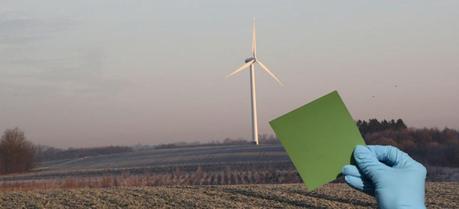 Solid oxide electrolysis cells can store the energy from wind turbines. (Credit: Technical University of Denmark)
Solid oxide electrolysis cells can store the energy from wind turbines. (Credit: Technical University of Denmark)A new report points out that the ability to store large amounts of energy will be paramount for the future sustainable energy system in Denmark.
According to the Danish energy strategy 50% of the electricity consumption has to be covered by wind power by 2020, and in 2035 the entire demand for electricity and heat has to be met by sustainable energy sources. This creates challenges, as the wind does not always blow when you need it. A key part of such an energy system will necessarily be the ability to store large amounts of energy and convert it to electricity as needed.
A project group with participants from Danish industry and research institutions has just published their recommendations for the coming Danish efforts within research, development and demonstration of energy storage technologies.
The report, which has section leader Allan Schrøder Pedersen from DTU Energy Conversion as the main editor, identifies three areas within energy storage in Denmark that should be focused on: chemical energy storage, batteries and thermal energy storage.
Energy can be stored in chemical compounds by splitting water into hydrogen and oxygen using electrolysis. This converts electrical energy into chemical energy in the hydrogen molecules. The hydrogen can be stored and at a later time reconverted into electricity in a fuel cell. Solid oxide electrolysis cells (SOEC) operating at high temperature can also split CO2, creating CO. In this way a mixture of hydrogen and CO, known as synthesis gas, is produced which by standard methods can be converted into liquid synthetic fuels. This allows the penetration of non-fossil fuels into the transport sector using the existing refueling infrastructure. Denmark has a strong standing within electrolysis, both as regards research and industrial development.
Batteries are a well-known technology. However, to store very large amounts of electricity better batteries and higher charging/decharging rates are needed. To achieve this, it is necessary to develop new battery types. Several Danish universities conduct battery research. While there are no battery producers in Denmark today, the future potential for commercial opportunities within, e.g., control and integration of battery solutions, is good.
Thermal energy storage, i.e. storage of energy in the form of heat, is presently used in Denmark in connection with combined heat and power plants for district heating. In future, thermal energy storage will play an even greater role, e.g., in connection with seasonal storage of heat from solar heaters. Several Danish companies and research institutions are already involved in thermal energy storage. This has created a significant Danish knowledge base for further development.
In this connection, Allan Schrøder Pedersen states that “energy storage will play a significant role in the future energy system, not only in Denmark but worldwide. Our recommendations will enable Danish companies and research institutions to play a constructive role in this development”.
The report has been prepared at the request of the publicly funded Danish energy research, development and demonstration programs. The report further recommends that the Danish activities take place in close collaboration with international partners in the EU and elsewhere, and it identifies a need for demonstration and pilot plants to mature the technology development.

